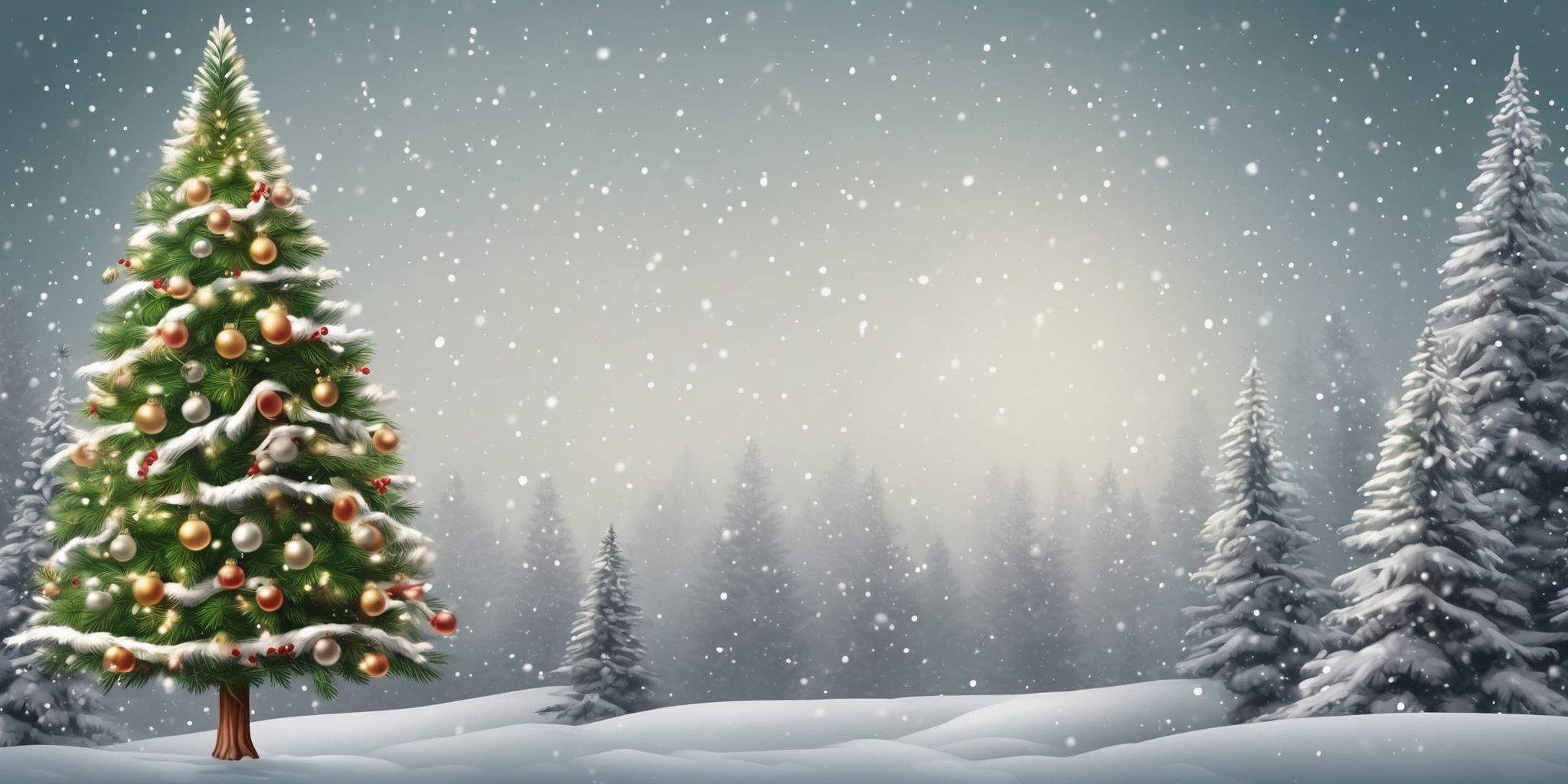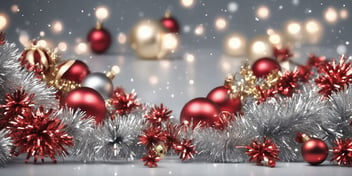- Blog
- Christmas trees
- Shaping the Perfect Christmas Tree: Tips and Techniques

The snow is falling, carols are playing, and jolly old Saint Nicholas is on his way. Yes, it's that time of the year again - the season to adorn our homes with the most magnificent of all symbols: the Christmas tree. But how do we transform a simple conifer into a work of art that captures the spirit of the holidays? Fear not, for we are here to impart the wisdom and secrets of shaping the perfect Christmas tree.
With a little bit of technique, a touch of creativity, and a sprinkle of festive magic, get ready to transform your living room into a mesmerizing winter wonderland that would make even Santa Claus himself envious.
Choosing the Right Tree
Consider the Space and Size
When shaping your Christmas tree, it's important to consider the space and size of the area where it will be placed. A tree that is too large for the room can overwhelm the space and make it difficult to maneuver around. On the other hand, a tree that is too small can look out of place and lack impact.
Take measurements of the area where the tree will be positioned to ensure a proper fit. Consider the height of the ceiling and the distance from furniture or other objects. This will help you choose a tree that complements the space and allows for easy movement. Remember, a well-proportioned tree will enhance the overall visual appeal of your Christmas decor.
Decide on the Tree Type
When deciding on the tree type, consider the shape that best suits your preferences and space. Some popular tree shapes for Christmas include:
- Full or round shape: Provides a traditional and lush appearance.
- Slim or narrow shape: Ideal for smaller spaces or if you prefer a less bulky tree.
- Pencil or column shape: Takes up minimal space while still adding a festive touch.
- Natural shape: Embraces the tree's original form, allowing for a more organic and rustic look.
Each shape has its own unique charm, so choose the one that aligns with your desired aesthetic and fits well within your room.
Inspect the Tree's Health and Quality
- Check for signs of freshness, such as vibrant green color and resilient needles that do not easily fall off.
- Examine the branches and trunk for any damage, breakage, or signs of disease or pests.
- Gently shake the tree to ensure minimal needle drop, indicating good health.
- Look for a straight and sturdy trunk that will provide stability once decorated.
- Avoid trees with brown or dry patches, as they may not last throughout the holiday season.
- Opt for a tree with a well-balanced shape and evenly spaced branches to create an appealing display.
Preparing the Tree for Decoration
Prune and Shape the Tree
Pruning and shaping your Christmas tree is an important step in achieving a visually appealing appearance. By removing excess branches and trimming uneven growth, you can create a more balanced and symmetrical shape. Use pruning shears to carefully trim overgrown branches, ensuring you maintain the tree's natural form. Balancing the branches by strategically trimming certain areas can also help create a fuller look.
For instance, if the lower branches are bushier than the upper ones, selectively remove some foliage to achieve a more even distribution. Remember to step back occasionally to assess the tree's shape and make adjustments as needed.
Trimming Overgrown Branches
Trimming overgrown branches is an important step in shaping Christmas trees. It helps create a balanced and aesthetically pleasing appearance. Start by identifying any excessively long or unruly branches that disrupt the overall shape. Use sharp pruning shears to carefully trim these branches, ensuring clean and precise cuts. Removing excessive growth enhances the tree's symmetry and allows ornaments to hang evenly.
Additionally, it prevents overcrowding and improves air circulation within the tree, ensuring the branches remain healthy throughout the holiday season. Avoid cutting too much at once to maintain the tree's natural look.
Balancing Uneven Branches
Balancing uneven branches is an important aspect of shaping Christmas trees. It ensures a symmetrical and visually appealing appearance. To achieve balance, start by identifying branches that are longer or sticking out prominently. Trim these branches slightly to match the overall shape of the tree.
Additionally, gently adjust the position of branches that are crowded or overshadowing others. By evenly distributing the branches, you can create a more balanced and aesthetically pleasing look for your Christmas tree. Remember to step back frequently and assess the tree from different angles while shaping to achieve the desired balance.
Lighting and Garland Placement
Choose the Right Lights
When choosing lights for your Christmas tree, consider the shape and size of your tree. Opt for lights that will enhance the tree's overall appearance and not overpower it. For taller trees, longer strands of lights may be needed to ensure even coverage.
Additionally, consider the color and type of lights that will complement your tree decorations. Warm white lights create a cozy ambiance, while multicolored lights add a festive touch. LED lights are energy-efficient and last longer, making them a popular choice. Experiment with different types of lights to find the perfect fit for your Christmas tree shape.
Start with the Garland
Once you have chosen the right Christmas tree shape, it's time to start decorating. Begin by hanging the garland. This forms the foundation of your tree's overall design and helps to shape its appearance. Opt for a garland that complements your tree's color scheme or theme. Start from the top and work your way down, securing the garland evenly around the branches. Consider using different types of garland, such as bead or tinsel, to add texture and dimension to your tree. Layering the garland in a zigzag pattern can create an interesting visual effect. Remember to step back and assess the placement as you go to ensure a balanced and harmonious look.
Tinsel vs. Bead Garland
When it comes to decorating your Christmas tree, choosing between tinsel and bead garland can have an impact on its shape:
- Tinsel: This shimmering option adds sparkle and texture to your tree. However, its reflective surface can sometimes hide the natural contours of the branches, making it challenging to appreciate the tree's shape fully.
- Bead Garland: Unlike tinsel, bead garland is more transparent and allows for better visibility of the tree's branches. This can highlight the tree's shape, creating a more defined and aesthetically pleasing look.
By opting for bead garland, you can accentuate the natural form of your Christmas tree, showcasing its symmetry and fullness.
Garland Placement Techniques
When it comes to garland placement techniques for shaping Christmas trees, consider starting from the top and working your way down in a spiral motion. This helps to evenly distribute the garland and create a visually pleasing effect.
Additionally, vary the length of the garland strands to add depth and dimension to your tree. For a traditional look, opt for classic green garland, while metallic or beaded garlands can add a touch of glamour. Experiment with different styles and textures to personalize your tree and achieve the desired shape.
Hanging Ornaments and Decorations
Create a Theme or Color Scheme
Creating a theme or color scheme for your Christmas tree can enhance its overall shape and visual appeal. Choose a theme that reflects your personal style or complements your home decor.
For example, you could opt for a traditional theme with classic red and green ornaments, or go for a modern and elegant look with silver and gold accents. This cohesive theme will tie all the decorations together and create a harmonious display. By carefully selecting ornaments and decorations that align with your chosen theme, you can ensure that your Christmas tree shape and overall design are visually pleasing and cohesive.
Hang Ornaments of Different Sizes
Hang ornaments of different sizes to create depth and visual interest in your Christmas tree shape. Start by placing larger ornaments near the base of the tree and gradually work your way up with smaller ones. This technique adds dimension and helps distribute the visual weight evenly. Mix various sizes and shapes, such as round, cylindrical, and decorative figurines, to achieve a balanced and visually appealing result.
For instance, combine larger ball ornaments with delicate snowflakes and smaller baubles. Experiment with different placements until you achieve a harmonious arrangement that enhances the overall shape of your tree.
Using Ornament Hooks
Using sturdy and reliable ornament hooks is important for maintaining the shape of your Christmas tree. These hooks securely hold your ornaments in place, reducing the risk of them falling and causing branches to bend or break. Look for hooks that are easy to attach and remove, as well as ones that can support the weight of your ornaments. S-shaped hooks or wire hooks are popular choices. When hanging ornaments, make sure to distribute them evenly across the tree to maintain its balanced shape.
Avoid using flimsy hooks that may not withstand the weight of your decorations and could potentially damage your tree.
Attaching Ornaments Securely
To ensure your Christmas tree maintains its shape, it is important to attach ornaments securely. This will prevent them from falling off and potentially damaging the tree or any delicate decorations. Use secure ornament hooks or strings that are strong enough to hold the weight of the ornaments. Avoid using flimsy or weak materials that may snap easily.
Additionally, consider attaching heavier ornaments closer to the trunk of the tree to distribute the weight evenly and maintain the tree's balance. By taking these simple precautions, you can enjoy a beautifully decorated tree that stays in shape throughout the holiday season.
Adding the Tree Topper
Choose a Tree Topper Style
When it comes to choosing a tree topper style, consider your overall Christmas tree shape. For a traditional look, opt for a star or an angel topper. These classic options complement a symmetrical tree with evenly spaced branches. If you have a more modern or eclectic tree shape, you can get creative with alternative toppers like ribbon bows, large bows made from decorative fabric, or even a quirky figurine that represents something meaningful to you.
Remember, the tree topper should be proportional to the tree's size and not overpower the rest of the decorations. Experiment with different styles to find the one that best suits your tree's shape and your personal taste.
Securely Position the Tree Topper
To securely position the tree topper, it's important to choose a style that fits the size and shape of your tree. Consider tree toppers like stars, angels, or bows that can be easily attached or fastened to the top branch. For added stability, use an adhesive substance or tie the topper securely to the tree with wire or ribbons. Avoid placing heavy or oversized toppers that may cause the tree to become unbalanced.
A securely positioned tree topper adds the perfect finishing touch to your Christmas tree shape, ensuring it stays in place throughout the holiday season.
Maintaining the Tree's Shape
Water the Tree Regularly
Watering the Christmas tree regularly is crucial for maintaining its shape and keeping it fresh throughout the holiday season. A well-hydrated tree is less likely to dry out, resulting in drooping branches and a lackluster appearance. To ensure proper hydration, check the tree's water level daily and replenish it as needed. Make sure the tree stand allows for easy access to the water reservoir. A general rule of thumb is to provide one quart of water per inch of trunk diameter.
By consistently watering your Christmas tree, you can preserve its shape and vibrancy, creating a stunning centerpiece for your festivities.
Avoid Overloading the Branches
To maintain the shape of your Christmas tree, it is important to avoid overloading the branches. Here are some tips to keep in mind:
- Distribute ornaments evenly throughout the tree, placing heavier decorations closer to the trunk to prevent sagging.
- Consider the weight of each ornament before hanging it. Choose lightweight ornaments or use hooks that don't add excessive strain on the branches.
- If using garlands or tinsel, be mindful of their weight as well. Avoid wrapping them too tightly around the branches, which can cause them to droop.
- Regularly inspect the tree to ensure that the branches are not bending or becoming imbalanced due to the weight of the decorations.
By following these guidelines, you can keep your Christmas tree looking aesthetically pleasing and maintain its desired shape throughout the holiday season.
Balance Weight Distribution
To maintain the desired shape of your Christmas tree, it is crucial to balance the distribution of weight on the branches. Uneven weight can lead to sagging or tilting, diminishing the tree's overall appearance. To achieve balance, evenly distribute your ornaments throughout the tree, placing heavier ones closer to the trunk and lighter ones towards the outer branches.
Additionally, consider varying the placement of decorations, alternating sides and heights, to create visual harmony. By ensuring a balanced weight distribution, your Christmas tree will retain its shape and create a visually appealing centerpiece for the holiday season.
Wrapping up
When it comes to decorating the perfect Christmas tree, there are a few tips and techniques that can make all the difference. Start by choosing the right tree, whether it's a real or artificial one. Pay attention to its shape and size, making sure it fits your space and preferences.
Next, invest in a sturdy tree stand to keep it secure and straight. After that, it's time to fluff and shape the branches, creating a full and symmetrical look. Layer your lights from the inside out, ensuring an even distribution. Add garlands and ornaments, mixing different sizes, colors, and textures for visual interest.
Finally, top it off with a beautiful tree topper that complements the overall theme. Remember, the key is to be creative and have fun, making your Christmas tree a stunning centerpiece for the holiday season.
Read On

The Art of Christmas Tree Hanging: Tips and Tricks
‘Tis the season to be jolly, fa la la la la, la la la la! As the delightful scent of pine fills the...

Essential Tips for Christmas Tree Trimming to Make Your Holiday Season Extra Special
Ah, the enchanting scent of pine filling the air, sparkling lights illuminating the room, and the...

Expert Tips for Beautifully Decorating Your Christmas Tree
It's that magical time of the year again - when twinkling lights, jolly tunes, and the unmistakable...